When a patient has a cracked molar or a screaming toothache at midnight, they’re not flipping through a phone book.
They’re grabbing their phone and typing “emergency dentist near me.”
If your practice isn’t showing up at the top of that search, you’re invisible. And invisible practices don’t get new patients. They lose them to the competition.
Here’s the ugly truth most dental practices don’t want to hear: If you’re not investing in serious, strategic SEO right now, you’re already behind.
Not slightly behind. Miles behind.
And every month you stay stuck on page two (or worse), you’re handing revenue directly to the guy down the street who figured this out three years ago.
SEO for general dental practices isn’t optional in 2025. It’s survival.
It’s sustainable patient acquisition. And it’s the difference between a practice that grows year over year — and one that wonders why the phones are so damn quiet.
I’ve spent the last 10+ years building SEO roadmaps that turned sleepy dental offices into booked-solid machines. Last month alone, one of my clients pulled 47 new patient appointments directly from organic search. (And no, they didn’t need TikTok dances or gimmicky ads to do it.)
I’m pulling back the curtain to show you:
- What dental SEO actually looks like today (not five years ago)
- How to fix what’s killing your online visibility
- Which proven strategies get phones ringing and appointment books filled — fast
No sugarcoating. No buzzwords. Just the real stuff that works.
Let’s get into it.
Key Takeaways:
- SEO Is Essential: If you’re not on page 1 for terms like “emergency dentist near me,” you’re invisible and losing patients.
- Own Local Search: Optimize your Google Business Profile, maintain consistent NAP listings, target neighborhood-specific pages, and get steady positive reviews to land in the Local 3-Pack.
- Fast, Mobile-First Site Matters: A secure site that loads under 2 seconds on mobile builds trust—slow or outdated sites drive patients away.
- High-Quality, Expert Content Wins: Publish in-depth, dentist-reviewed articles answering real patient questions and use schema so Google (and AI) recognizes your authority.
- Track Metrics and Invest Wisely: Use GA4, Search Console, and call tracking. Budget $1,500–$2,500/month for SEO—expect a 5×–12× ROI through steady new-patient flow.
Step-by-Step Guide to SEO for General Dental Practices
Most dental practices are running on hope when it comes to Google. Hope is not a strategy. SEO is.
71% of patients start their search for a new dentist online, according to a 2024 Healthcare Consumer Insight Report. If you’re not showing up — high up — you’re dead to them. They’ll pick someone else without thinking twice.
Here’s exactly how to start fixing that, one step at a time.
Step 1: Understand the New Rules of Dental SEO in 2025
First thing you need to know: SEO today is not the SEO you remember from 2015.
Keyword stuffing? Dead.
Spammy backlinks? Dead.
Lazy, templated blogs? Beyond dead.
Google’s Helpful Content Update, its March 2024 Core Update, and GEO changed the game. Now, if your website doesn’t offer real value and authentic expertise, you’re not just ignored. You’re actively buried.
In dentistry, that means:
- Detailed, patient-focused service pages (not copied boilerplate)
- Blogs that answer real patient questions, not generic fluff
- A site that’s fast, secure, mobile-friendly, and easy to use
Google wants to rank the best local dental experts, not the ones who spammed the most keywords.
If you can’t prove your practice is legit online? You’re toast.
Step 2: Dominate Local SEO Like Your Practice Depends on It (Because It Does)
Most of your new patients aren’t coming from across the country. They’re coming from five miles away. Maybe less.
Local SEO is your lifeline. If your practice isn’t ranking in the Google Local Pack (those three map listings at the top), you’re losing patients to competitors, guaranteed.
Here’s what you need to dominate locally:
- Google Business Profile fully optimized — every field filled, every category chosen carefully, real patient reviews constantly flowing in
- Consistent NAP (Name, Address, Phone) across every site — Yelp, Healthgrades, your local Chamber of Commerce, everywhere
- Location-based service pages — don’t just say “dentist in [City].” Create separate pages targeting services and neighborhoods you serve
According to a recent survey, 98% of people read online reviews for local businesses, and 87% won’t consider a business with a low star rating.
That’s the playing field. It’s brutal. And it’s not changing anytime soon.
Step 3: Build a Website That Doesn’t Suck (And Yes, Patients Notice)
Here’s a hard truth: Patients judge your dental skills based on your website. They don’t care how many degrees are hanging in your office if your site looks like it hasn’t been updated since the Bush administration.
Modern dental websites must be:
- Mobile-first — over 68% of healthcare searches happen on mobile devices (Think with Google)
- Fast as hell — load under 2 seconds or you lose almost half your visitors
- Secure — SSL encryption (HTTPS) is the bare minimum
Pro tip: Run your site through Google’s PageSpeed Insights. If you’re scoring under 85 on mobile? Fix it immediately.
A slow, clunky, or outdated website tells patients one thing: “You’re behind the times. Can’t even manage a website — how are you going to manage my teeth?”
Step 4: Get Serious About Dental Content (No, AI Junk Doesn’t Count)
AI tools like ChatGPT are exploding. Guess what else is exploding? Garbage dental content.
And Google’s algorithm is onto it.
Your dental blog needs to:
- Answer real patient questions (e.g., “Can I get a cavity under a crown?” not “How important is dental hygiene?”)
- Be written or reviewed by real experts — dentists, hygienists, ortho specialists
- Focus on depth, originality, and local relevance
Pro Tip: Create content clusters around major services.
Example: A cluster for “Dental Implants” might include:
- Cost of dental implants in [City]
- Dental implants vs. bridges: which is better?
- How long do dental implants last?
Cluster strategy = Authority + Relevance = Rankings.
Bonus: Websites that regularly publish expert content see 434% more indexed pages and 97% more inbound links.
Step 5: Track Everything — or Fly Blind
Hope is not a KPI. If you’re not tracking your SEO performance, you’re not doing SEO. You’re guessing.
Here’s the minimum you should have set up:
- Google Analytics 4 for traffic and behavior tracking
- Google Search Console for monitoring keyword rankings and technical issues
- Call tracking software (like CallRail) to tie new patient leads back to search traffic
Watch these metrics like a hawk:
- Organic traffic (month over month growth)
- Local keyword rankings
- Calls/forms submitted from organic search
- Conversion rate of site visitors to appointment requests
What gets measured gets managed. Ignore the numbers, and you’ll stay stuck wondering why nothing’s working.
2025 Dental SEO Must-Haves
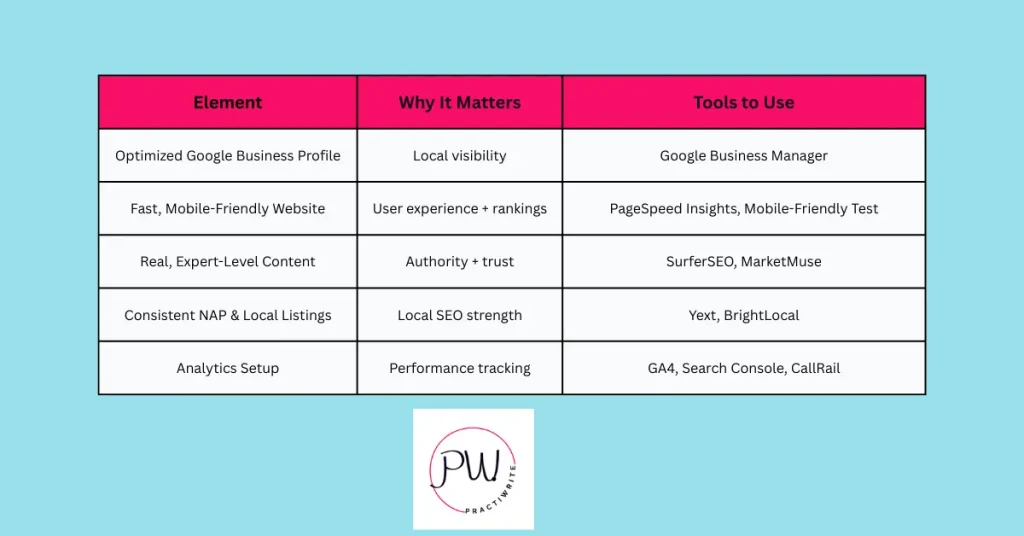
Competitive Pricing for Dental SEO Services
Let’s get real about money.
SEO isn’t a luxury for dental practices anymore. It’s an investment in patient acquisition. But too many practices treat SEO pricing like it’s a shady backroom deal — either scared they’re getting ripped off or convinced they can cheap their way to the top.
Here’s the truth: You get what you pay for.
And bad SEO is way more expensive than good SEO — because bad SEO doesn’t deliver squat.
Let’s break down what real dental SEO costs in 2025 — and what you should expect for your money.
What Dental SEO Actually Costs in 2025
Based on the latest 2024 industry benchmarks from Ahrefs, Moz, and UpCity’s SEO Pricing Report:
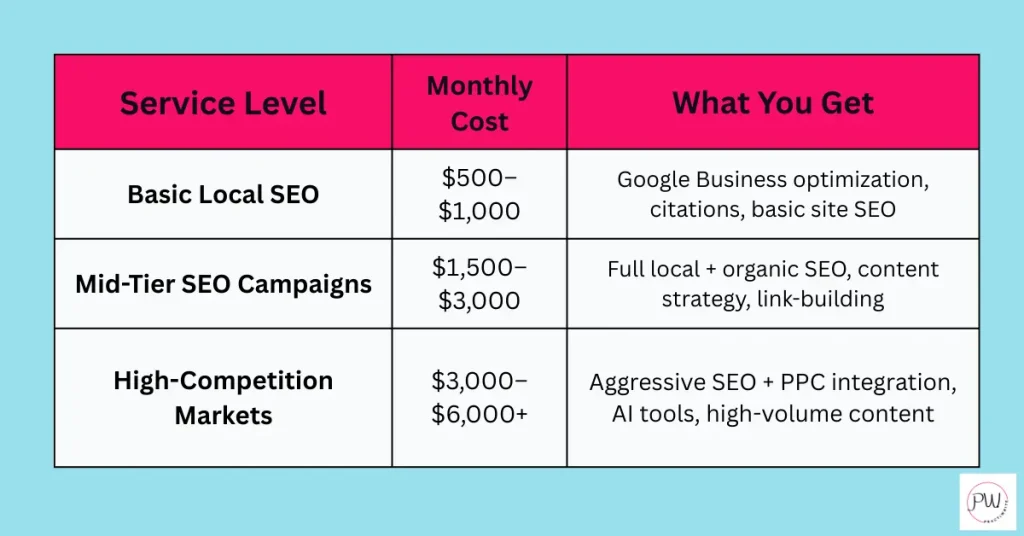
Reality check: Most general dental practices doing serious SEO — not “check-the-box” nonsense — spend $1,500 to $2,500 per month. That’s your ballpark if you actually want results that move the needle.
Anything less than $1,000/month? Be skeptical. Either you’re getting half-efforts, AI junk, or an “SEO company” that hasn’t updated their strategies since Invisalign was new.
Why Dental SEO Pricing Isn’t One-Size-Fits-All
A good SEO partner will price based on real factors, not cookie-cutter packages. Here’s what drives your costs:
- Location: Major cities (Boston, Dallas, LA) = higher competition = higher spend
- Market Competition: More dentists fighting for the same keywords? More work needed.
- Website Status: Brand new website or outdated clunker = more upfront work
- Scope: Are you just doing local SEO? Or also blog content, backlinks, reputation management?
Another major cost driver? Your goals. If you want a modest 10% growth, that’s one thing.
If you want to dominate your city and triple your patient flow (frankly, I don’t work with any dental practices that don’t want to dominate), it’s a different animal (and budget).
Bottom line: There’s no magic “cheap and fast” SEO plan that builds a top-3 ranked practice. If someone says otherwise, run.
Understanding the ROI of Dental SEO (Not Just the Cost)
Here’s where smart practice owners think differently: They don’t just look at the bill. They look at the return.
On average, SEO delivers a 5X to 12X ROI for dental practices who stick with it, based on our own SEO ROI Analysis.
Translation:
- Spend $2,000 a month = $24,000 a year
- Bring in 30–50 new patients from organic search (each worth $1,000+ lifetime value minimum)
- Net $30,000–$50,000 extra revenue for that $24K investment — or way more if you factor in patient referrals and treatment plan upsells
And remember: SEO results snowball. Organic rankings build authority over time, meaning patient flow grows without needing constant ad spend.
Paid ads are rented space. SEO is owned land. Which one would you rather build your practice on?
What Impacts Dental SEO Pricing
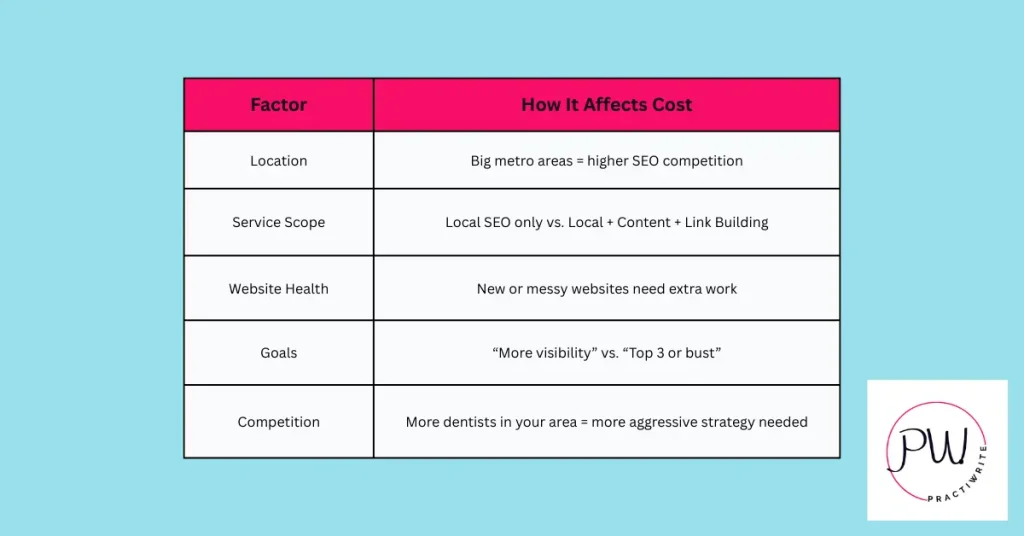
Future Trends in Dental SEO: What’s Coming (and How to Stay Ahead)
Most dental practices are already five years behind. If you’re still playing catch-up when the next wave of SEO shifts hit? You’re toast.
The practices that thrive through 2025 and beyond will be the ones who move early, not react late. Here’s where dental SEO is headed — and how you can stay ahead of the curve while everyone else scrambles.
1. AI Will Change How Patients Search — and How You Show Up
Artificial intelligence isn’t coming. It’s already here.
AI-driven platforms like Perplexity and Google’s AI Overviews are changing how patients search for dentists. Instead of getting a big list of links, patients will start getting AI-curated answers.
Which means ranking #1 won’t be enough anymore — you need to be the trusted source the AI pulls from.
Action steps:
- Write content that answers patient questions clearly and comprehensively.
- Use structured data and schema markup so AI can understand and pull from your site.
- Regularly update service pages and blog posts to stay fresh — outdated content gets skipped.
Pro Tip: If you’re not optimizing for AI search behavior by mid-2025, expect a sharp traffic drop-off by 2026.
2. The Google Maps Pack Is the New Front Page
Here’s another brutal truth most dental practices are ignoring: If you’re not ranking in the Google Maps Pack, you’re invisible to local patients.
When someone searches “dentist near me,” the top 3 map listings (also called the “Local 3-Pack”) get over 60% of the clicks — before anyone even sees the organic results, according to BrightLocal’s 2024 Local Consumer Survey.
If you’re stuck below the fold? You might as well not exist.
Why the Maps Pack matters for dentists:
- Emergency and urgent care searches default to local results
- “Near me” intent searches almost always trigger map results first
- Mobile-first patients (which is basically everyone) interact with maps faster than scrolling pages
To dominate the Maps Pack, your SEO needs to focus heavily on:
- Google Business Profile optimization
- Local citations and directory consistency
- Proximity, prominence, and relevance factors (Google’s 3 pillars of local ranking)
This is exactly why I created The Dental Practice SEO Sprints — a proven system designed specifically to help dental practices break into (and stay locked inside) the Maps Pack for high-converting keywords (and every area of search).
(I’ll be dropping a full guide on how to conquer the Maps Pack soon.Trust me, it’ll be worth the read.)
But for now, know this: If you’re not in the Maps 3-Pack, you’re losing patients daily — whether you realize it or not.
3. Voice Search Will Explode (and You’d Better Sound Good)
By 2026, it’s projected that 8.4 billion voice assistants will be in use worldwide according to Statista. That’s more voice searches than human beings.
And guess what? People don’t talk like they type.
Example:
- Typed search: “Best dentist Boston”
- Voice search: “Who’s the best dentist near me open late tonight?”
Action steps:
- Target conversational keywords: Build in full-sentence phrases.
- Answer specific questions: Create FAQ sections based on real-world voice queries.
- Speed matters: Voice search prioritizes fast, mobile-optimized sites.
If you’re still writing like a keyword robot, voice search will eat you alive.
4. Local SEO Will Get Even More Ruthless
Google is doubling down on hyper-local relevance. The 2024 Core Update already slammed websites that pretended to be “local” without proof (physical address, reviews, citations).
Going forward, dental practices must:
- Get hyper-specific: Mention actual neighborhoods, suburbs, landmarks in your content.
- Win local reviews: Volume, quality, and recency of reviews matter more than ever.
- Optimize for “Near Me” searches: Pages built around local queries will crush generic “City Dentist” pages.
Example: Instead of just optimizing for “Dentist in Tampa,” build location pages like:
- “Emergency Dentist Downtown Tampa”
- “Pediatric Dentist Near Hyde Park Tampa”
Pro Tip: The more hyper-local you go, the more Google trusts you’re the best choice for that specific patient.
5. UX and Human-Centric Design Will Become Ranking Factors
Google’s coming algorithm updates will care even more about how real people interact with your site. In plain English: If your site frustrates or bores people, you’ll sink.
Expect heavier weighting for:
- Page experience signals (speed, mobile-friendliness, layout stability)
- Engagement metrics (bounce rate, time on page, pages per session)
Action steps:
- Cut the clutter: Clean, simple navigation wins.
- Fast load times: Especially on mobile.
- Clear CTAs (calls-to-action): Patients should always know what to do next.
If your website isn’t laser-focused on patient experience? No amount of SEO “tricks” will save you.
Where Dental SEO is Headed by 2026
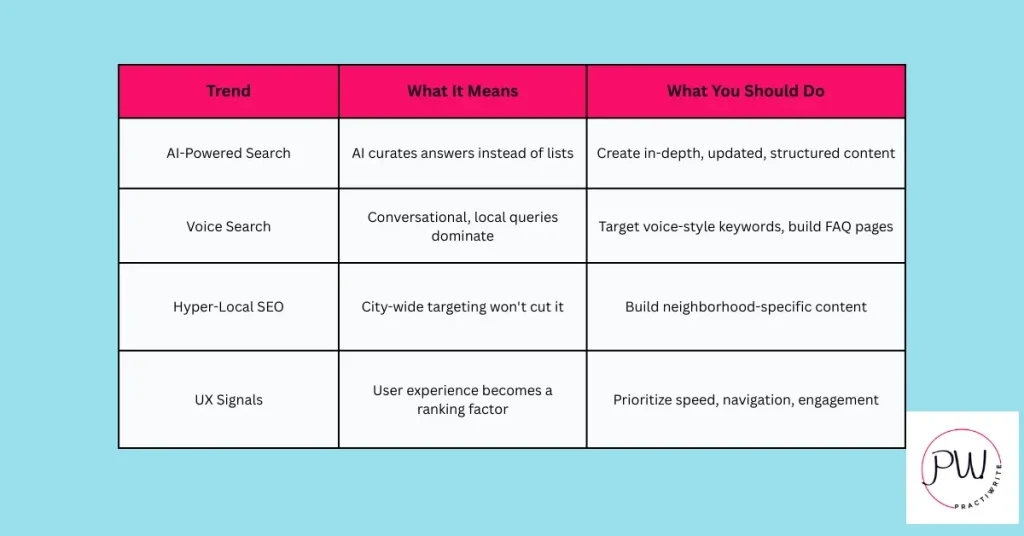
Troubleshooting Common SEO Problems for Dental Practices
If your SEO isn’t working, it’s not a mystery. It’s not bad luck. It’s cause and effect.
Either your strategy sucks, your execution sucks, or both.
The good news? SEO failures leave a paper trail. If you know where to look, you can fix them before they tank your practice’s growth.
Here’s how to diagnose and repair the most common dental SEO problems — fast.
Low Website Traffic? Start Here.
If your website traffic is flatter than an old bottle of Coke, something’s broken upstream.
Top causes of low dental website traffic:
- Weak or nonexistent keyword strategy (you’re not targeting what patients actually search)
- Poor on-page SEO (missing title tags, sloppy meta descriptions, no internal linking)
- No local optimization (your practice is invisible to nearby patients)
- Technical SEO disasters (site’s slow, unsecure, not mobile-friendly)
Quick Fixes:
- Audit your keywords: Use SEMrush or Ahrefs to find what patients are actually typing in your area.
- Refresh your Google Business Profile: Update photos, services, hours, and actively request new reviews.
- Check your site speed: Run a test with PageSpeed Insights and fix slow-loading pages immediately.
- Fix mobile issues: Use Google’s Mobile-Friendly Test — if you fail, prioritize a mobile-responsive redesign.
Remember: No traffic = no leads. No leads = no patients.
People Visit Your Site… and Leave (High Bounce Rate)
If people land on your site but bounce off faster than a dropped drill bit, your site isn’t doing its job.
Top causes of high bounce rate:
- Ugly or outdated design
- Slow load times
- Confusing navigation
- Thin, unhelpful content
Quick Fixes:
- Simplify your homepage: Patients should immediately understand who you are, what you offer, and how to book.
- Speed up your site: Compress images, reduce scripts, upgrade hosting if necessary.
- Create patient pathways: Every page should guide visitors to the next logical step — like booking a consultation.
- Be ruthlessly helpful: Patients don’t care about your mission statement. They care about solving their problem. Fast.
Stat to know: A 1-second delay in mobile load time can drop conversions by up to 20%, according to Google’s Mobile Speed Playbook.
You’re Ranking — But Still Not Getting New Patients
This is the silent killer. You check your SEO reports.
Traffic’s growing.
Rankings are up.
But your appointment book looks the same.
Top causes of poor conversion despite traffic:
- Wrong keywords (you’re ranking for junk terms that don’t bring patients)
- No clear call-to-action (CTA)
- Trust signals missing (no reviews, no testimonials, no authority)
Quick Fixes:
- Target high-intent keywords: Focus on service and emergency keywords (e.g., “emergency dentist near me,” “root canal specialist [City]”).
- Place CTAs everywhere: Appointment buttons, phone numbers, contact forms — above the fold, at the bottom, in sidebars.
- Show proof fast: Slap patient reviews, awards, and before-and-after photos right on your homepage and service pages.
Traffic without conversions is like a full waiting room with no treatments happening. Fix the leaks or lose the revenue.
Fast SEO Diagnosis Guide
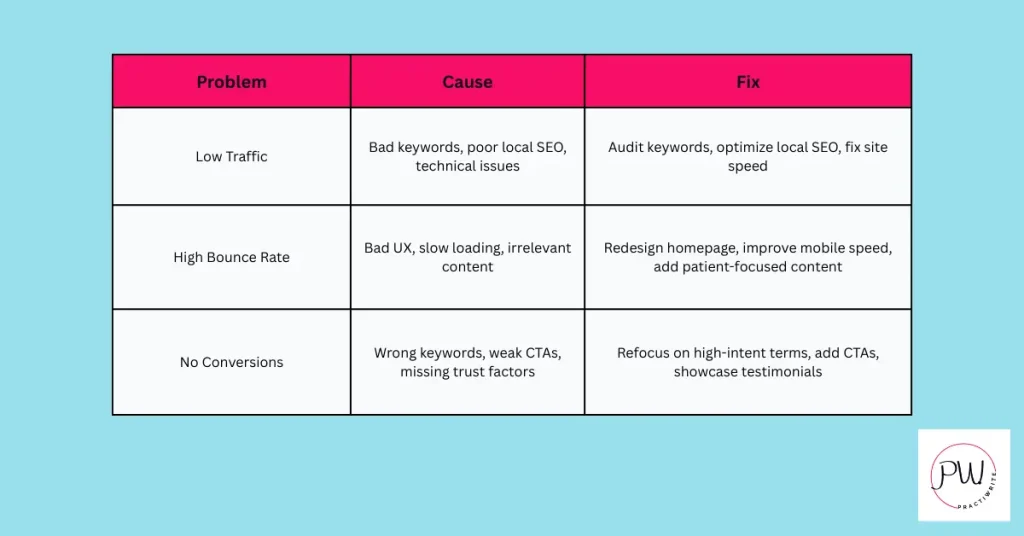
A Final Word: Dental SEO Isn’t Optional — It’s the Engine of Your Growth
Let’s be clear: If your dental practice isn’t showing up on Google — in organic results, in the Maps Pack, in AI-driven answers — you’re losing patients.
Not someday. Right now.
And every month you wait, the practices that get it pull even farther ahead.
Dental SEO isn’t about tricks or shortcuts anymore. It’s about building real visibility, real trust, and real patient flow — on a foundation you actually own.
You’ve seen what it takes:
- A fast, mobile-first website that patients trust within seconds
- Google Business domination that locks down the Maps Pack
- Authority-level content that AI and humans both love
- A relentless focus on local, real-world patient intent
The opportunity is massive. But only if you move while everyone else is still stuck wondering why their phones are dead.
Ready to See Exactly What’s Possible for Your Practice?
If you’re serious about growing your practice — and you’re done wasting time on random advice that doesn’t work — let’s talk.
Book a Free, No BS Dental Practice SEO Strategy Session with Practiwrite. In 30 minutes or less, I’ll show you:
✅ Where you’re leaking patients right now
✅ What it’ll take to dominate your local search results
✅ A clear, customized Dental Practice SEO Roadmap you can actually use
No spam. No sugarcoating. No sales pressure.
Just a clear path from “invisible” to “unstoppable.”
Your future patients are already searching.
It’s time they find you first.
10+ year content strategist, writer, author, and SEO consultant. I work exclusively with dental practices that want to grow and dominate their local areas.
